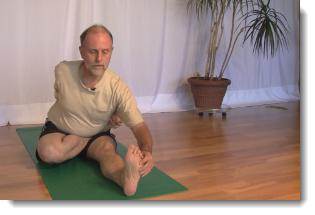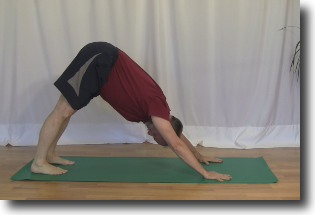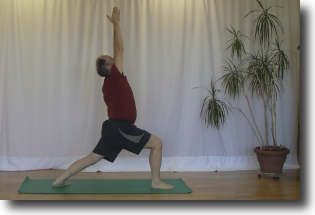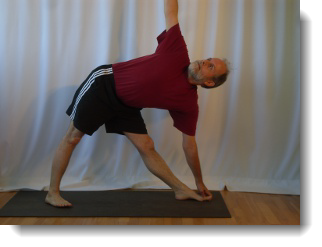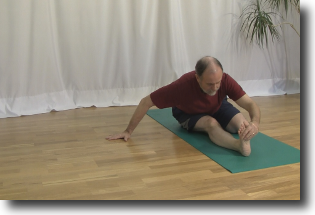
“Yoga related injuries are on the rise”. Alice has found a way to not be a statistic in this headline.
The news is bad.
Injuries due to yoga are on the rise in Canada. More people than ever are showing up at hospital emergency rooms or their doctor’s office with yoga related injuries.
Part of this increase is due to the increasing number of people doing yoga and the other part is due to people doing yoga poorly.
Alice’s yoga teacher talked about this during their first yoga class and many times since. Yoga is a safe activity as long as you follow a few simple guidelines.
Alice is following these five guidelines to protect herself from injury during her yoga practice.
- Be mindful
- Always warm up
- Check your alignment
- Avoid hyper extension
- Use props
All five of these will contribute to an injury free practice but the first one, be mindful, is the most useful and the most difficult to accomplish especially if you are new to yoga.
1 – Be mindful
Being mindful in your yoga practice means that you pay attention to what your body is saying to you when you enter a yoga pose.
For example if you are attempting Ardha Baddha Pashimottasana, and your knee is complaining that it hurts when you bring your heel into your hip, then you need to start listening to this feedback from your body and back off until the knee stops complaining.
When you are new to yoga it is difficult to listen to your body and not try to go so far into a pose. Your ego is pushing you to do the pose as well as the teacher and you are willing to accept some pain so that you can do the pose as well as the teacher.
You need to develop the habit of accepting the current limitations of your body and only going as far into a pose as you are comfortable.
Accepting the limitations of your body and only going as far as the body is telling you is alright will take you a long way to preventing injuries and it will keep you out of the hospital emergency room.
Warming up the body will also lead to an injury free practice.
2 – Always warm up
Every sport or physical activity recommends that you warm up your body before you get started. Yoga is the same. Before you start working on the more demanding poses you need to warm up the muscles, tendons and ligaments.
In the Ashtanga style of yoga and several other vigorous styles of yoga you start your practice by doing a series of Sun Salutes. Other less vigorous styles of yoga start with gentle stretches and less challenging yoga poses to warm the body up.
You can also use Ujjayi Breath to warm up the body. Ujjayi breath brings a large amount of oxygen into the body and this additional fuel will increase your metabolism. The more you breathe with the Ujjayi Breath the hotter your body will become.
Warming up with these poses and the Ujjayi Breath results in increasing the blood flow to the muscles which prepares them for the more vigorous poses that are to follow. Your joints get lubricated during the warm up and they will be less prone to injury as a result.
Now that you are more mindful and you have warmed up your muscles and joints it is time to move on to a couple of more things that you can do to avoid injury while you are doing the rest of your yoga practice. First we start with checking your alignment.
3 – Check alignment
If you have poor alignment in a yoga pose, it will not matter how warm your body is nor how mindful you are you will still injure yourself and then you will be off to visit with your doctor.
It is very important that you learn the proper alignment of your feet, knees, back, shoulders and wrists in each pose that you are doing. All of your joints and muscles are at risk when you do a pose with improper alignment.
Your teacher can help you get your body into proper alignment. They can give you modifications or alternate poses if you body is not ready for the particular pose that the class is doing.
Poor alignment results in stress to the joints, ligaments, tendons and muscles. This imbalance will result in injury and pain.
Getting the proper alignment will reduce the tension in the muscles and strengthen both sides of a joint and as a result you will find that over time you will become more flexible and able to move further into a pose.
Once you get the alignment right and you start to develop some increased flexibility you need to watch out for hyper extension.
4 – Avoid hyper extension
Hyper extension results from moving a joint to far. It most often happens with the knees and elbows.
When you hyper extend a joint you end up locking it. For example hyper extending your knee means moving it backwards which results in the bones pressing into each other and injury to your joint, ligaments, tendons and muscles.
You can avoid hyper extending your joints by always keeping a very small bend in your joint. Check with your teacher. They will be able to tell you if you are hyper extending your joint and help you to remove it.
The opposite of hyper extension is a problem as well. If your joints or muscles are too tight and they are preventing you from attempting a pose safely then you need to take action to protect yourself by using some props.
5 – Use Props
You use the props when the body is not flexible enough to get into the pose properly and when unsupported you could possibly injure yourself and then you will end up as another yoga injury statistic.
Props take two forms. You can use your body as a prop or you can use other objects such as blocks, foams, belts and bolsters to support your body in a pose and protect yourself from injury.
Props help to support the muscles and joints while they begin to stretch and move into proper alignment. The props take the unbalanced stress out of the joints and support you as you develop the flexibility required to do the pose safely.
Summary
Alice is intent on not becoming part of the Yoga Injury headline. She is implementing all five points that her teacher shared with her when she started doing yoga. She is confident that as long as she follows these guidelines that she will stay out of the her doctor’s office and have an excellent yoga practice as well.
You can easily injure yourself if you are not careful when you start a yoga practice. If you keep these five guidelines in mind when you do your yoga practice you will greatly reduce your risk:
- be mindful
- warm up
- good alignment
- avoid hyper extension
- use props
Next Step
Work with your yoga teacher when you practice yoga. They will help you to implement these five guidelines and make sure that you have an injury free and safe yoga practice.

